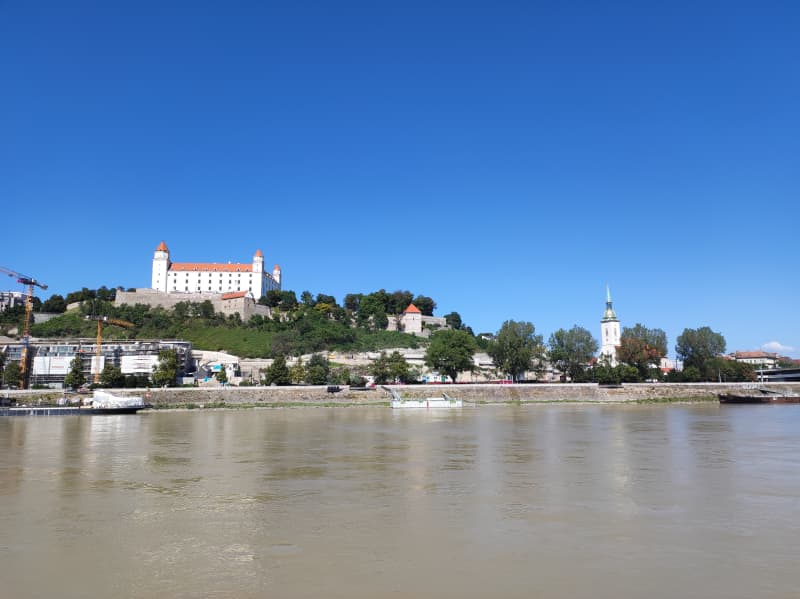
The European Meteorological Society annual conference hosted in the University of Economics in Bratislava on 3-8 September 2023 showcased several talks on the progress of the European Centre for Medium-Range Weather Forecasts’ digital twins for Destination Earth (DestinE).
ECMWF scientists explained some of the advances made towards the Weather-induced Extremes (Extremes DT) and the Climate Change Adaptation (Climate DT) digital twins that the Centre is building in the frame of DestinE, the ambitious initiative of the European Union to create a digital twin of the Earth system.
The EMS annual conferences are an important gathering for climate and weather scientists, being an excellent opportunity to share ideas and projects regarding the future of climate science and meteorology in Europe.
The 2023 edition, celebrated under exceptionally warm and sunny conditions, focused on drought and drought related challenges, with representatives from Slovakia explaining the recent impacts of extreme weather in the host Country during the welcome and strategic lectures session. The opening day also was the occasion to distribute the EMS Awards among the winners. EMS is the association of Meteorological Societies of Europe and has nearly 40 members and 30 associate members.
ECMWF is an Associate Member of the EMS and every year many of its scientists participate in the conference as conveners, chairpersons or speakers to explain key aspects of their work.
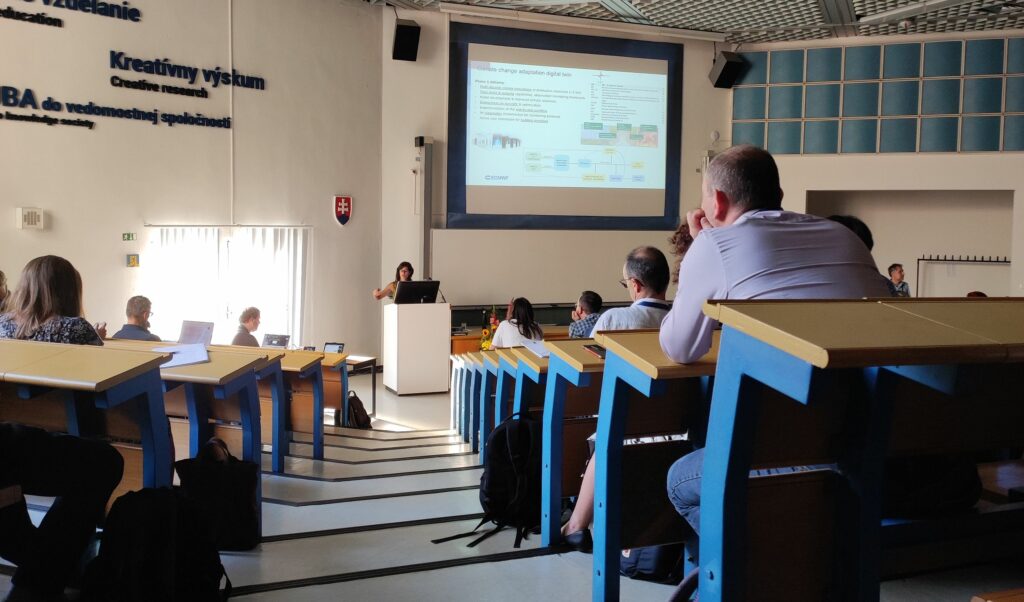
First results of ECMWF’s Extremes DT
The talks of ECMWF’s Destination Earth team focused mainly on the methodology and progress of the global, continuous component of the Extremes DT being developed by ECMWF. The On-demand component of the Extremes DT and the Climate DT are being developed by two consortiums led by Météo France and CSC IT Center for Science, respectively, with the coordination of ECMWF.
Estibaliz Gascón, scientist for Destination Earth at ECMWF, gave the Operational Systems and Applications keynote speech on Tuesday 5 September describing the features of the Extremes DT and in particular the continuous component. After an introduction about the DestinE initiative and the role of ECMWF, she explained in more detail the area she is involved in, the Continuous component of the Extremes DT.
ECMWF, in partnership with a wide range of contractors and collaborators across Europe, is producing enhanced simulations of the Earth system for climate and extreme weather prediction. This new type of information system will be interactive and configurable and includes the impact sector, representatives of the most climate and weather sensitive socioeconomic sectors, working with the users from the earliest stages in order to produce data and workflows they can extract and adapt to their specific needs.
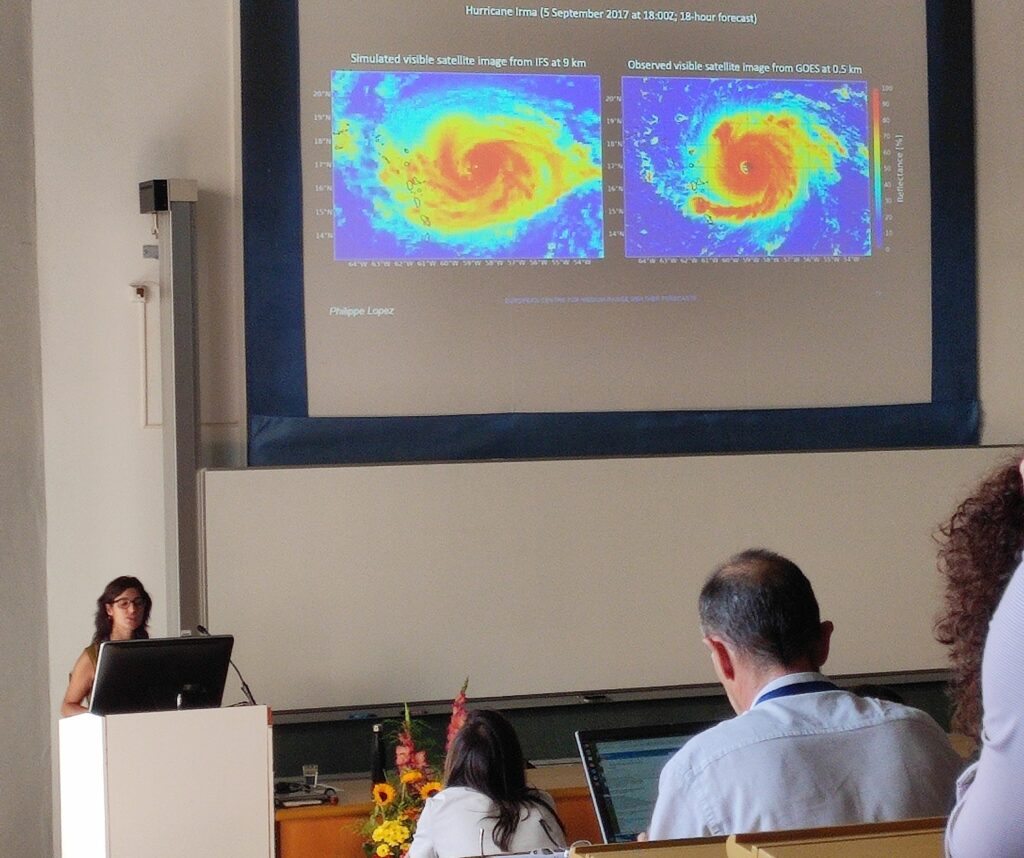
The Extremes DT has an On Demand component, being developed by a consortium led by Météo France. ECMWF is working on the Continuous component. This particular aspect of the Extremes DT is producing a higher resolution global forecast model, to better assess weather extremes, becoming more frequent with climate change. The first tests are focused on running the ECMWF’s Integrated Forecasting System at 4.5 km resolution (the current operational resolution is 9 km) for a set of extreme events, and some daily forecasts from 2016 to 2021.
The team is also running daily forecasts at 4.5 km that keep providing data about the performance of the simulations during emerging extreme events.
The first results show a good performance of the higher resolution model runs to predict the intensity of tropical cyclones.
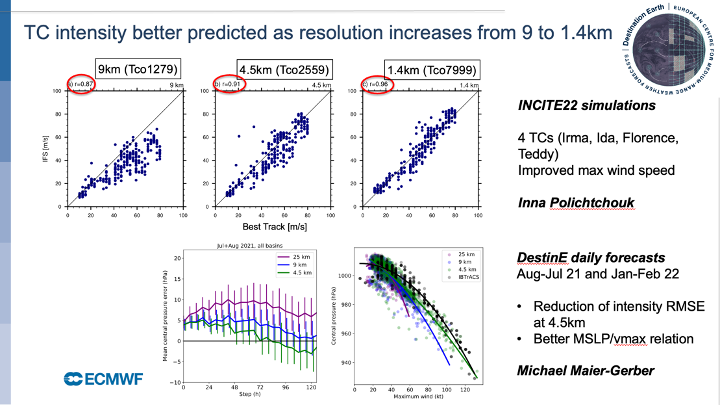
The keynote was followed by a lively Q&A session.
“Throughout the EMS Annual Conference many colleagues have shown a strong interest in Destination Earth and the ambitious objectives we are pursuing, during the official and the informal talks. It’s good to see the many and very relevant questions our interventions generate. It is also very encouraging to share the first experiments with experts from across Europe and experience, first person, the interest on our work. It was a pleasure to be in Bratislava” said Estíbaliz Gascón.
In a separate talk on Thursday 7 September, ECMWF scientist shared some more results of the first experiments with the Extremes DT Continuous component.
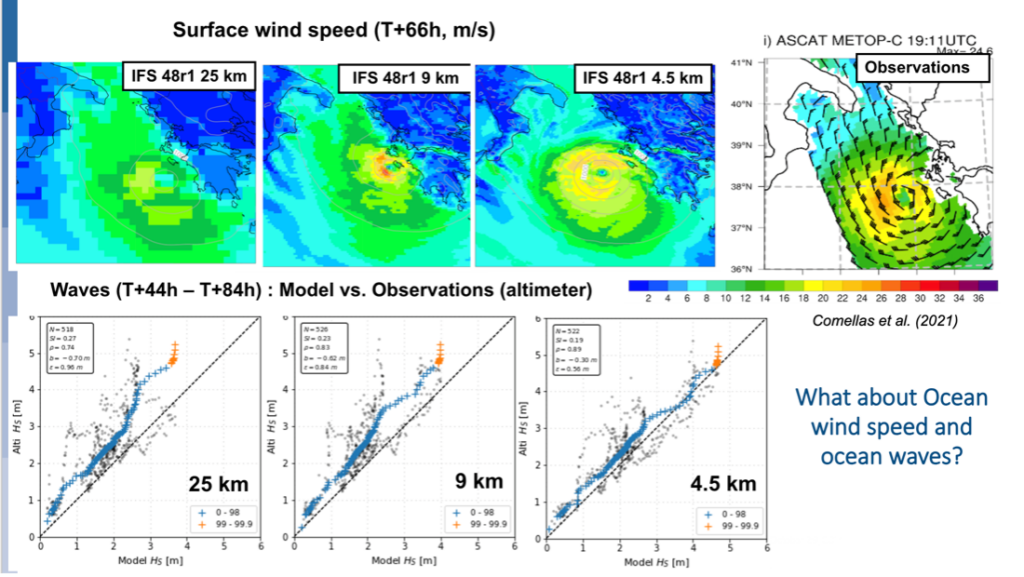
The Destination Earth team at ECMWF has tested modelling Medicane Ianos, that hit Greece in September 2020, with different configurations and with model runs at different resolutions. The improvement in representing both surface wind speed at sea and waves is remarkable, as shown above. The team also carried out insightful experiments to test the impact of different sea surface temperature (SST) initial conditions on the subsequent development of the storm.”
Disruptive techniques for uncertainty quantification
Mariana Clare, Scientist for Machine Learning at ECMWF Research Department presented the general lines of her work “Creating skillful and reliable probabilistic forecasts using machine learning” in which she described her innovative work along with ECMWF’s Thomas Haiden to apply a Bayesian Neural Network to a deterministic forecast (those providing a “single solution” to the question of “What the weather will be like?) to obtain a probabilistic forecast.
Numerical Weather Prediction (NWP) has traditionally run “ensemble forecasts”, producing multiple runs of the model with different initial conditions that add a range of randomness into the initial conditions and model simulations. This provides an array of possible outcomes to quantify the degree of uncertainty. However, such techniques involve complex and computationally expensive operations.
This novel technique can be applied to both “traditional” NWP weather forecasts, that try to solve the physical equations, and to purely data-driven weather forecasts, that are increasingly being developed at a fast pace.
ECMWF scientists have shown that applying the Bayesian Neural Network to a deterministic forecast can consistently predict the probability distribution of the forecast error, therefore providing a probabilistic forecast without ensemble runs. Moreover, for the variables looked at so far, these probabilistic forecasts are often better than the operational ensemble (see slide below).
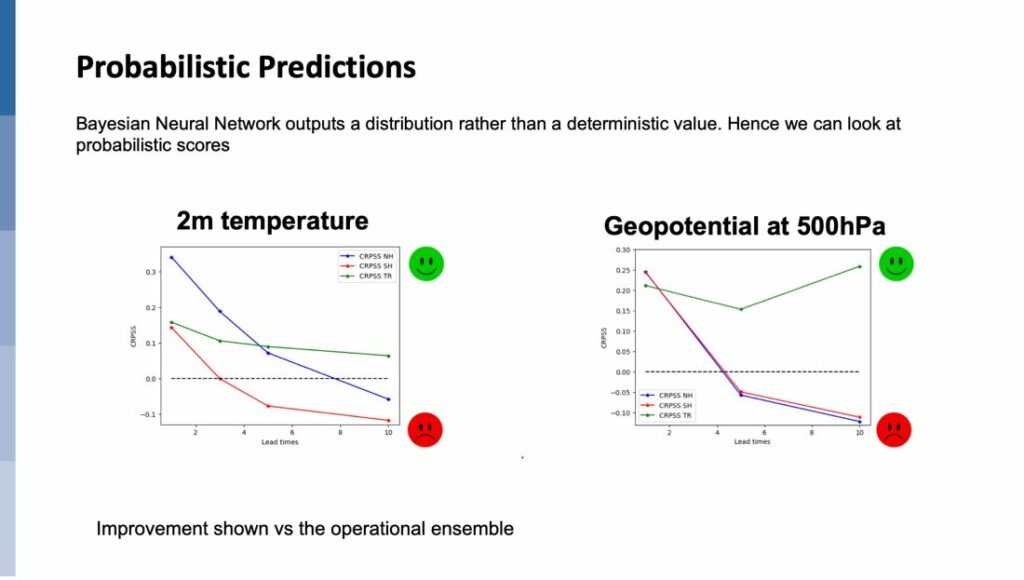
This is an important development for Destination Earth and ECMWF digital twins as it can solve the issue of uncertainty quantification for simulations at very high resolutions, such as those being developed by ECMWF, where running ensembles would be computationally unsustainable.
Ivana Aleksovska, ECMWF Scientist at the Uncertainty Quantification Department explained her work to apply the Ensemble Model Output Statistic (EMOS) for post-processing ensemble forecasts, reducing systematic errors and biases. EMOS is one of the most commonly used post-processing methods, and Ivana’s work has shown the performance of EMOS to provide uncertainty quantification of Destination Earth’s Continuous Extremes digital twin experimental simulations at short time spans. This work is another promising approach to solve the issue of uncertainty quantification of very high-resolution Earth system simulations.

“We have shown that with EMOS, we can sample post-processed members that can be used to quantify uncertainty. The ensembles generated using EMOS trained on probabilistic operational forecasts combined with DestinE continuous runs have a better Continuous Ranked Probability Score CRPS score than ensembles generated using only operational ensembles or DestinE continuous run, for two variables, 2mT and 10ff.” said Ivana Aleksovska.
“This was my first time at the EMS annual conference. I was more than happy to meet various researchers from all over the world, who came to present their work, and to discover the broad spectrum of applications of meteorology. What’s more, meeting the experts who asked us so many questions on the subject of Destination Earth was a real pleasure. Definitely an event to be attended again!” she added.
Enhancing the simulations’ performances
As mentioned earlier, in order to provide higher resolution simulations, several models’ parameters need to be adjusted. ECMWF scientists Llorenç Lledó and Josef Schröttle presented some of the efforts to solve these issues.
Josef Schröttle, Llorenç Lledo, Cristina Lupu, Chris Burrows, Tony McNally, Samuel Quesda Ruiz and Elias Holm have explored the benefits of assimilating a denser set of geostationary clear-sky radiance in order to obtain data at smaller scales that can then produce simulations at higher resolutions.
The first experiments with Eumetsat’s SEVIRI instrument, on board the Meteosat Second Generation satellite and NOAA/ NASA GOES satellites have shown that such denser sets of observations result in improved forecasting, allowing for higher resolution forecasts but without producing more correlated errors, as it happens when the model assimilates smaller scales but without increasing the weight of observations.
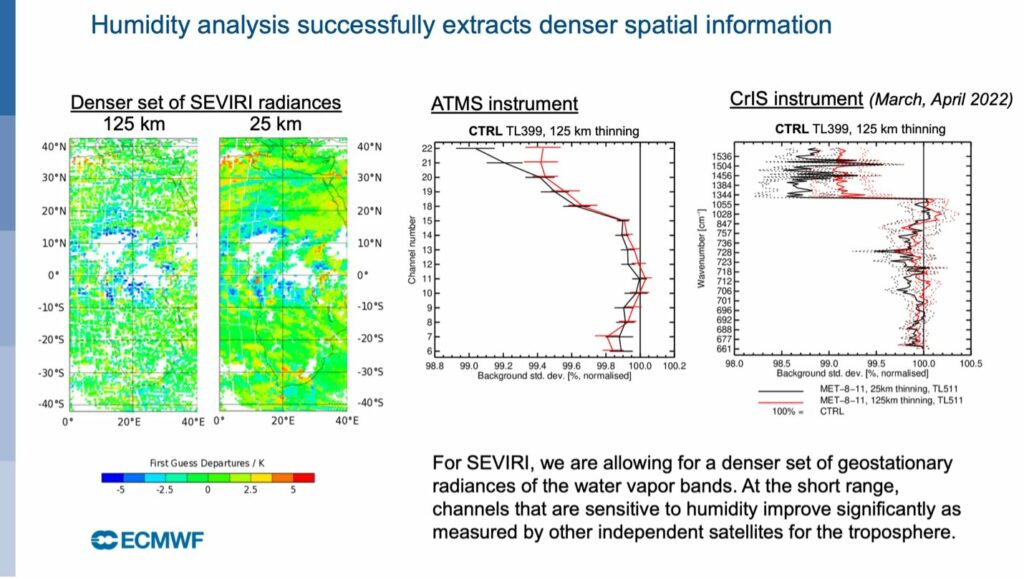
“For sure the stakes are high and producing this innovative information system is an immense challenge, but we are very happy with these first efforts, and we fully realise the extent of the work being done during this type of meetings with scientists from all disciplines and from all across Europe. Everyone we meet seems really interested in learning about the latest developments of ECMWF digital twins.” said Llorenç Lledó.
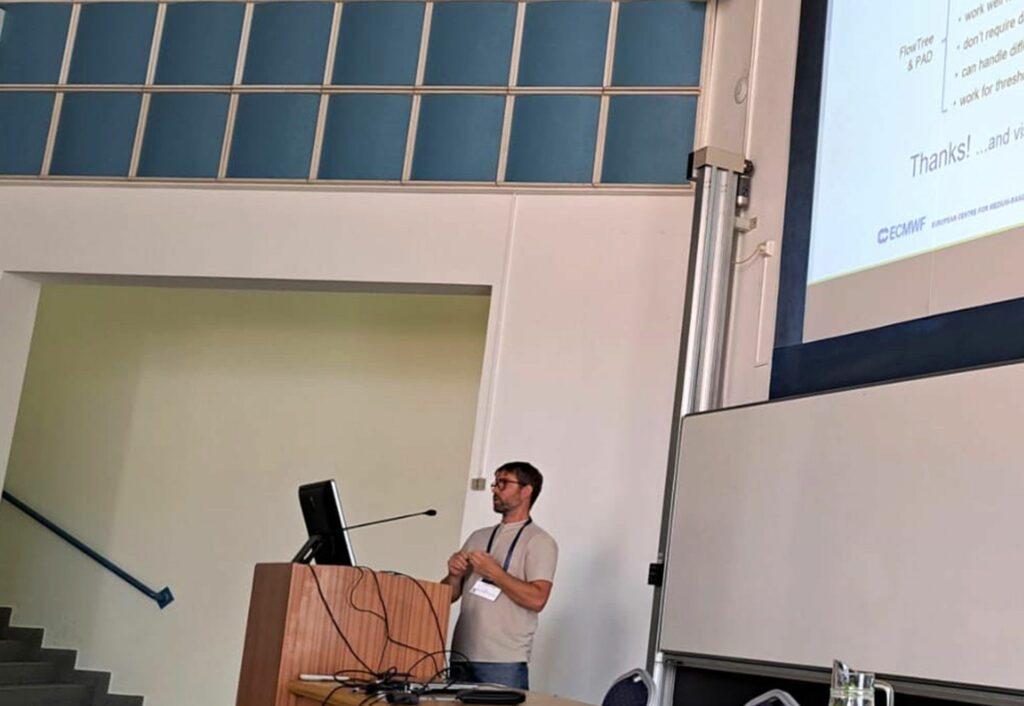
Llorenç Lledó, Thomas Haiden and Gregor Skok are tackling the elusive issue of estimating location errors in global km-scale precipitation forecasts. The Wasserstein distance is a theoretical solution to measure the distance between showers in forecasts and observations, but it cannot be computed operationally, especially at very high resolution. The Forecast Verification and Machine Learning communities have developed algorithms that can approximate the Wasserstein distance and ECMWF Destination Earth team shared their experiences with two of them, Flowtree and the Precipitation Attribution Distance methods, evaluating the advantages and disadvantages they’ve found.

The gathering in Bratislava was a great opportunity for ECMWF Destination Earth team to exchange ideas with colleagues from across Europe, but also to look back at the progress made in a short period of time, since the last EMS Annual Conference in Bonn, where the team has its headquarters.
Main picture: Bratislava Castle during the sunny days of the conference. Llorenç Lledó/ ECMWF
Destination Earth is a European Union-funded initiative launched in 2022, with the aim to build a digital replica of the Earth system by 2030. The initiative is being jointly implemented under the leadership of DG CNECT by three entrusted entities: the European Centre for Medium-Range Weather Forecasts (ECMWF), responsible for the creation of the first two ‘digital twins’ and the ‘Digital Twin Engine’, the European Space Agency (ESA) responsible for building the ‘Core Service Platform’, and the European Organisation for the Exploitation of Meteorological Satellites (EUMETSAT), responsible for the creation of the ‘Data Lake’.
We acknowledge the EuroHPC Joint Undertaking for awarding this project strategic access to the EuroHPC supercomputers LUMI, hosted by CSC (Finland), and the LUMI consortium, Marenostrum5, hosted by BSC (Spain) Leonardo, hosted by Cineca (Italy) and MeluXina, hosted by LuxProvide (Luxembourg) through a EuroHPC Special Access call.
More information about Destination Earth is on the Destination Earth website and the EU Commission website.
For more information about ECMWF’s role visit ecmwf.int/DestinE
For any questions related to the role of ECMWF in Destination Earth, please use the following email links:


